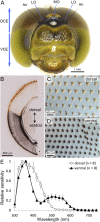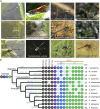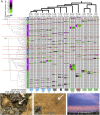Extraordinary diversity of visual opsin genes in dragonflies
- PMID: 25713365
- PMCID: PMC4371951
- DOI: 10.1073/pnas.1424670112
Extraordinary diversity of visual opsin genes in dragonflies
Abstract
Dragonflies are colorful and large-eyed animals strongly dependent on color vision. Here we report an extraordinary large number of opsin genes in dragonflies and their characteristic spatiotemporal expression patterns. Exhaustive transcriptomic and genomic surveys of three dragonflies of the family Libellulidae consistently identified 20 opsin genes, consisting of 4 nonvisual opsin genes and 16 visual opsin genes of 1 UV, 5 short-wavelength (SW), and 10 long-wavelength (LW) type. Comprehensive transcriptomic survey of the other dragonflies representing an additional 10 families also identified as many as 15-33 opsin genes. Molecular phylogenetic analysis revealed dynamic multiplications and losses of the opsin genes in the course of evolution. In contrast to many SW and LW genes expressed in adults, only one SW gene and several LW genes were expressed in larvae, reflecting less visual dependence and LW-skewed light conditions for their lifestyle under water. In this context, notably, the sand-burrowing or pit-dwelling species tended to lack SW gene expression in larvae. In adult visual organs: (i) many SW genes and a few LW genes were expressed in the dorsal region of compound eyes, presumably for processing SW-skewed light from the sky; (ii) a few SW genes and many LW genes were expressed in the ventral region of compound eyes, probably for perceiving terrestrial objects; and (iii) expression of a specific LW gene was associated with ocelli. Our findings suggest that the stage- and region-specific expressions of the diverse opsin genes underlie the behavior, ecology, and adaptation of dragonflies.
Keywords: color vision; dragonfly; molecular evolution; opsin.
Conflict of interest statement
The authors declare no conflict of interest.
Figures








References
-
- Jacobs GH. Comparative Color Vision. Academic; New York: 1981.
-
- Kelber A, Vorobyev M, Osorio D. Animal colour vision—Behavioural tests and physiological concepts. Biol Rev Camb Philos Soc. 2003;78(1):81–118. - PubMed
-
- Osorio D, Vorobyev M. A review of the evolution of animal colour vision and visual communication signals. Vision Res. 2008;48(20):2042–2051. - PubMed
Publication types
MeSH terms
Substances
Associated data
- Actions
- Actions
- Actions
- Actions
- Actions
- Actions
- Actions
- Actions
- Actions
- Actions
- Actions
- Actions
- Actions
- Actions
- Actions
- Actions
- Actions
- Actions
- Actions
- Actions
- Actions
- Actions
- Actions
- Actions
- Actions
- Actions
- Actions
- Actions
- Actions
- Actions
- Actions
- Actions
- Actions
- Actions
- Actions
- Actions
- Actions
- Actions
- Actions
- Actions
- Actions
- Actions
- Actions
- Actions
- Actions
- Actions
- Actions
- Actions
- Actions
- Actions
- Actions
- Actions
- Actions
- Actions
- Actions
- Actions
- Actions
- Actions
- Actions
- Actions
- Actions
- Actions
- Actions
- Actions
- Actions
- Actions
- Actions
- Actions
- Actions
- Actions
- Actions
- Actions
- Actions
- Actions
- Actions
- Actions
- Actions
- Actions
- Actions
- Actions
- Actions
- Actions
- Actions
- Actions
- Actions
- Actions
- Actions
- Actions
- Actions
- Actions
- Actions
- Actions
- Actions
- Actions
- Actions
- Actions
- Actions
- Actions
- Actions
- Actions
- Actions
- Actions
- Actions
- Actions
- Actions
- Actions
- Actions
- Actions
- Actions
- Actions
- Actions
- Actions
- Actions
- Actions
- Actions
- Actions
- Actions
- Actions
- Actions
- Actions
- Actions
- Actions
- Actions
- Actions
- Actions
- Actions
- Actions
- Actions
- Actions
- Actions
- Actions
- Actions
- Actions
- Actions
- Actions
- Actions
- Actions
- Actions
- Actions
- Actions
- Actions
- Actions
- Actions
- Actions
- Actions
- Actions
- Actions
- Actions
- Actions
- Actions
- Actions
- Actions
- Actions
- Actions
- Actions
- Actions
- Actions
- Actions
- Actions
- Actions
- Actions
- Actions
- Actions
- Actions
- Actions
- Actions
- Actions
- Actions
- Actions
- Actions
- Actions
- Actions
- Actions
- Actions
- Actions
- Actions
- Actions
- Actions
- Actions
- Actions
- Actions
- Actions
- Actions
- Actions
- Actions
- Actions
- Actions
- Actions
- Actions
- Actions
- Actions
- Actions
- Actions
- Actions
- Actions
- Actions
- Actions
- Actions
- Actions
- Actions
- Actions
- Actions
- Actions
- Actions
- Actions
- Actions
- Actions
- Actions
- Actions
- Actions
- Actions
- Actions
- Actions
- Actions
- Actions
- Actions
- Actions
- Actions
- Actions
- Actions
- Actions
- Actions
- Actions
- Actions
- Actions
- Actions
- Actions
- Actions
- Actions
- Actions
- Actions
- Actions
- Actions
- Actions
- Actions
- Actions
- Actions
- Actions
- Actions
- Actions
- Actions
- Actions
- Actions
- Actions
- Actions
- Actions
- Actions
- Actions
- Actions
- Actions
- Actions
- Actions
- Actions
- Actions
- Actions
- Actions
- Actions
- Actions
- Actions
- Actions
- Actions
- Actions
- Actions
- Actions
- Actions
- Actions
- Actions
LinkOut - more resources
Full Text Sources
Other Literature Sources

